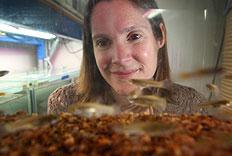Guppies play the mating game
GUPPIES are among the most promiscuous fish, scientists have discovered over decades of study, but new research from the University of Western Australia has established that when females are confined to one partner, their offspring exhibit behaviour that may be more likely to promote their survival.

GUPPIES are among the most promiscuous fish, scientists have discovered over decades of study, but new research from the University of Western Australia has established that when females are confined to one partner, their offspring exhibit behaviour that may be more likely to promote their survival.
Natives of Trinidad and Tobago, the fish are popular as aquarium pets everywhere. They have also been the focus of many studies of polyandry, which occurs when females mate with two or more males in one reproductive cycle and therefore produce eggs fertilised by more than one male.
Research on the effects of polyandry by husband-and-wife team Jonathan Evans and Jennifer Kelley, from UWA's Centre for Evolutionary Biology, has been published in the Royal Society journal Biology Letters.
Kelley is an expert in shoaling and schooling behaviour. The former is the normal association between fish in groups, while the latter is their synchronised movement when confronted with a predator.
In their latest experiment, Evans artificially inseminated guppies in order to produce full and half siblings, and compare their behaviour.
In the wild, females' choice of multiple male partners, and the propensity of males to forcibly mate with females, militates against the production of full siblings.
Earlier studies of guppies have shown females that mate with many males produce larger broods, have better shoaling ability and are better at escaping predators.
"We were expecting to find more benefits of multiple-mating, but we found a cost instead," Kelley says.
Because they were artificially inseminated, females were deprived of any element of choice in mating: unlike in the wild, they could not select their mate visually, nor engage in "cryptic female choice", that is, favouring the sperm of one male over others within their reproductive tract.
Kelley and Evans were surprised to find full siblings shoaled better than half siblings. "They were further apart from each other and didn't spend as much time together," Kelley says of the mixed groups.
"The fact that we didn't find the benefits of polyandry suggests that post-copulatory mechanisms may play an important role in determining the benefits of multiple mating."
Kelley is interested in further research that could establish how full siblings recognise each other as soon as 24 hours after birth, and why they shoal better than half siblings.
Other outstanding issues are the implications for in-breeding and co-operative behaviour with kin.
For now, Kelley is studying a native Australian species, the rainbow fish, examining colour patterns, colour vision and shoaling behaviour.



